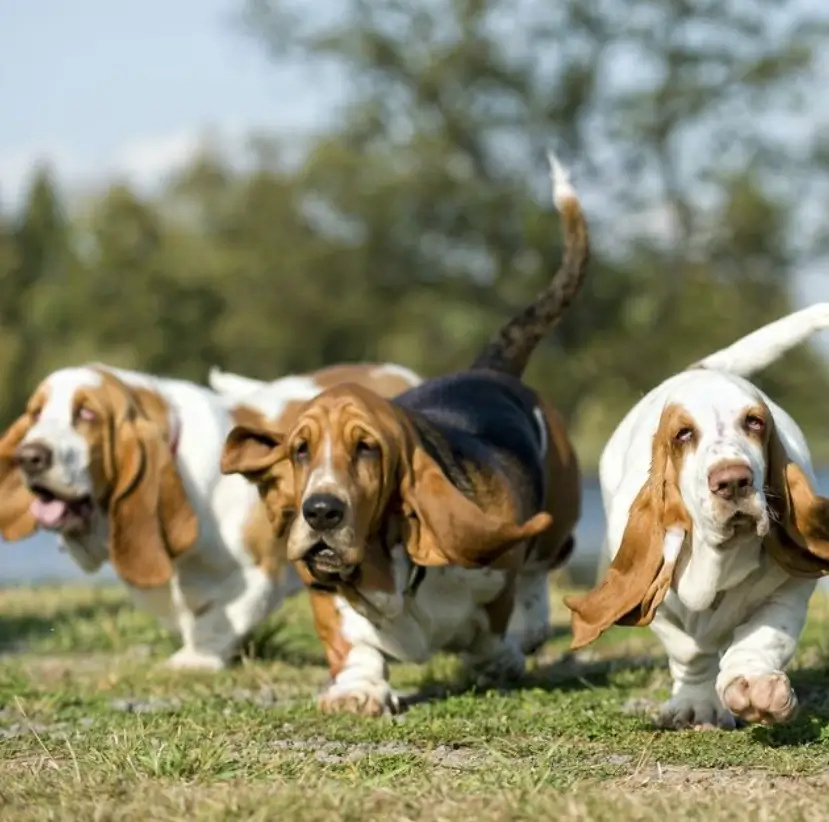Distinguished by its distinct appearance and roots in European breeding, the European Basset Hound offers a charming combination of gentle temperament and endearing traits. With their exaggeratedly droopy features, musical baying voices, and placid loyal dispositions, Basset Hounds hold enduring appeal for lovers of scenthounds.
The American and European lineages diverged long ago, but what exactly distinguishes the European Basset apart? Does their appearance and temperament differ substantially from across the pond? In this article, we dive into the world of the European Basset Hound to unravel its history, traits, and why it captures the hearts of dog enthusiasts worldwide.
What Does a European Basset Hound Look Like?
The European Basset Hound boasts distinctive features that set it apart from its American counterpart. Known for its longer legs and leaner build, the European Basset Hound exhibits a more athletic appearance. Their expressive, melancholic eyes, long ears, and loose, wrinkled skin contribute to their iconic charm, creating a captivating combination of elegance and undeniable cuteness.
Origin and Genetics
European Basset Hounds descend directly from the early French Bassets of the 16th century, bred as proficient small game hunters able to enter tunnels due to their dwarfism traits. Selective breeding pressure for certain physical exaggerations created a divergence between American and European Basset Hounds by the 1960s despite both originating from common French stock.
The dwarfism in Basset Hounds is linked to a condition called achondroplasia, which disrupts bone growth. This mutation became strongly fixed into Basset genetics due to deliberate preservation breeding. American Basset breeders further intensified dwarf features for stronger scent trailing abilities like very short legs and excessive skin folds.
In contrast, European standards maintained taller builds between 15 and 18 inches better suited for agility while hunting rough terrain, even if less efficient for scenting ability.
As a result, European Basset Hounds exhibit less exaggerated dwarfism with fewer wrinkles, longer ears, taller legs, and more moderate jowl folds compared to American Basset strains sharing common founding ancestors.
What is the Difference Between European and American Basset Hounds?
Subtle distinctions set the two Continental and Yankee strains apart, but European Basset Hounds are comparable to their across-the-pond relatives underneath that signature droopy-faced charm.
At their core, all Bassets channel steadfast devotion towards their families with playful patience that adapts wonderfully to most lifestyles given proper training boundaries and activity commitments met.
European vs American Basset Hounds: The Differences
Here is a table outlining some of the main differences between European and American Basset Hounds:
| Trait | European Basset Hound | American Basset Hound |
|---|---|---|
| Size | Taller (15-18 inches) | Shorter (12-15 inches) |
| Leg Length | Longer | Shorter, more exaggerated dwarfism |
| Ears | Very long and droopy, down to shoulders | Long but less low-hanging |
| Facial Skin | Moderate amount | Heavier wrinkles and loose upper eyelids |
| Coat Colors | Wide variety of coat colors | Usually tricolor patterned |
| Temperament | Steady, loyal | Goofier, more stubborn, louder baying |
| Prey Drive | Lower | Higher energy on scent trails |
| Availability | Much less common in the US | More popular and accessible in the US |
| Price | $1,200 – $2,000 | $800 – $1,500 |
In summary, subtle differences exist between lineages, but the temperament and appeal of a Basset Hound remain wonderfully constant in their dedication to family and irresistible charm.
Health Concerns
As relatively large dogs bred for genetic dwarfism, joint issues remain prevalent across all Basset Hounds, with some studies estimating upwards of 50% will develop hip or elbow dysplasia. Buyers should confirm breeder OFA certifications.
Other issues like eye/ear problems, bloating risk, and injury vulnerability from excited collisions also necessitate awareness. But overall, European and American Bassets remain relatively hardy with average 12-14 year lifespans.
Care and Grooming Practices
You should observe a range of care and grooming practices aimed at keeping your European Basset Hound healthy and comfortable. Common care and grooming practices for this particular breed include:
- Regular Exercise: European Basset Hounds may have longer legs than their American counterparts, but they still benefit from regular exercise to maintain a healthy weight and prevent boredom-related behaviors.
- Ear Cleaning: Due to their long ears, European Basset Hounds are prone to ear infections. Clean your dog’s ears regularly, checking for signs of redness, irritation, or wax buildup.
- Grooming the Skin Folds: European Basset Hounds have loose, wrinkled skin. Ensure the skin folds, especially around the face and neck, are kept clean and dry to prevent infections.
- Brushing: Brush your dog’s coat at least a few times a week to remove loose hair and prevent matting. Pay attention to areas with longer hair, such as the ears and tail.
- Bathing: Bathe your European Basset Hound as needed, typically every 4-6 weeks or when they get dirty. Use a dog-friendly shampoo, and thoroughly dry their skin and coat afterward.
- Dental Care: Don’t forget to brush your dog’s teeth regularly to prevent dental issues. Dental chews and toys can also contribute to oral health.
- Nail Trimming: Keep your Basset’s nails trimmed to a comfortable length. Regular walks on hard surfaces may help naturally wear down the nails, but check and trim as needed.
- Proper Nutrition: Feed your Basset a balanced and nutritious diet appropriate for its age, size, and activity level. Consult your vet to determine the best food for your European Basset Hound.
- Veterinary Check-ups: Schedule regular check-ups to monitor overall health. You should keep vaccinations up to date and discuss preventive care, such as flea and tick control.
- Positive Training: European Basset Hounds respond well to positive reinforcement training. Use treats, praise, and rewards to encourage good behavior and obedience.
How Much Do European Basset Hound Puppies Cost?
From reputable show breeders, you can expect European Basset Hound puppy pricing to range between $1200 to $2000 depending on pedigree history assurances.
Compared to American littermates, typically $800-$1500, European Basset Hound puppies carry slightly higher initial price tags thanks to limited breeder availability, compensating for transatlantic importing complexities. However, their eager-to-please temperaments and universally beloved comical appeal make the endeavor rewarding for the right owner!
Conclusion
Whether Continental or Yankee in origin, the iconic Basset Hound brings delightful character and steadfast loyalty, making them a cherished addition thriving through attentive early socialization and training reinforcement.
Ensure reputable health testing and moderate daily activity commitments for a happy and healthy Basset.
FAQs
Why are European Basset Hounds less common in the US?
Import restriction complexities plus already limited breeding stock availability even overseas result in substantially fewer litters with European pedigree assurances, making them relatively scarce stateside. But niche preservationist groups work diligently to uphold desirable breed traits.
Do European Basset Hounds shed less fur than American Bassets?
No major shedding divergences occur. Both sport smooth, dense coats that drop moderately year-round. Thorough weekly brushing remains essential for managing loose hair and preventing skin irritation regardless of ancestral continent origins.
Is the European Basset Hound a good apartment dog?
Yes, European Basset Hounds, like their American counterparts, can make good apartment dogs under the right conditions.
Are European Bassets better for first-time dog owners?
Their relatively mellower temperaments help novices adjust more smoothly to the demands of training a notoriously stubborn scenthound. However, European or American – extensive early socialization coupled with patient owners willing to uphold reward-based training proves vital for any Bassets to thrive long-term. Their silly antics necessitate supervision but repay delight lifelong!
Is the European Basset Hound a Recognized Breed?
The European Basset Hound is generally not recognized as a distinct breed by major kennel clubs like the American Kennel Club (AKC) or the Kennel Club in the United Kingdom. Instead, Basset Hounds are recognized as a single breed with variations in conformation standards between regions. The term “European Basset Hound” is often used colloquially to describe Basset Hounds with characteristics that may differ from those bred in North America.
